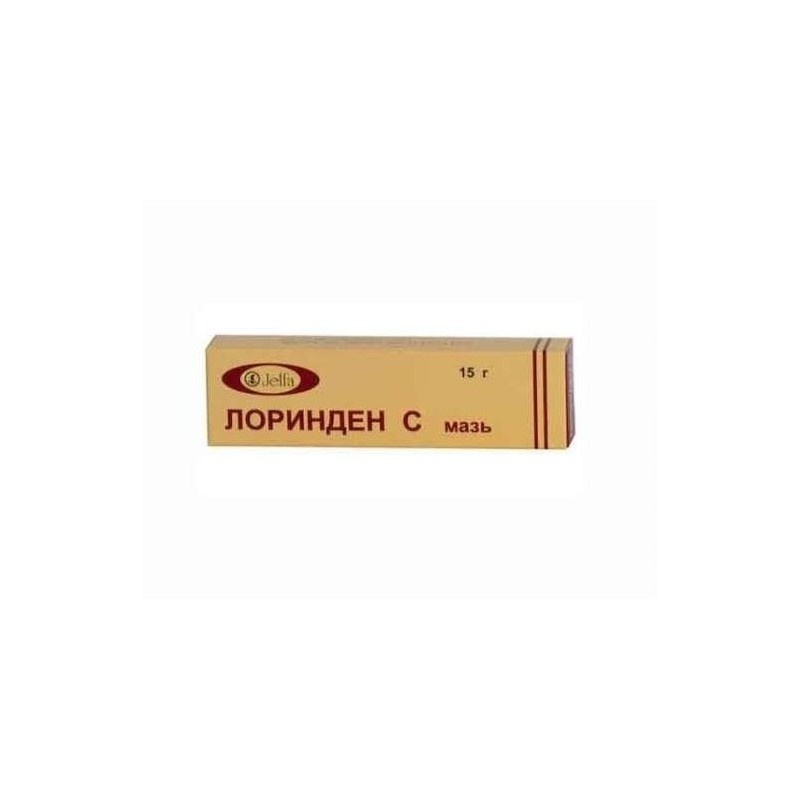

Lorinden C

Ask a doctor about a prescription for Lorinden C

How to use Lorinden C
Leaflet attached to the packaging: patient information
Warning! Keep the leaflet! Information on the immediate packaging in a foreign language.
LORINDEN C
(0.2 mg + 30 mg)/g, ointment
Flumetasoni pivalas + Clioquinolum
Table of contents of the leaflet
- 1. What is Lorinden C and what is it used for
- 2. Important information before using Lorinden C
- 3. How to use Lorinden C
- 4. Possible side effects
- 5. How to store Lorinden C
- 6. Contents of the packaging and other information
1. What is Lorinden C and what is it used for
Read the leaflet carefully before using the medicine, as it contains important information for the patient.
- Keep this leaflet, so you can read it again if you need to.
- If you have any doubts, consult your doctor, pharmacist, or nurse.
- This medicine has been prescribed specifically for you. Do not pass it on to others. The medicine may harm another person, even if their symptoms are the same.
- If you experience any side effects, including those not listed in this leaflet, tell your doctor, pharmacist, or nurse. See section 4.
Lorinden C ointment is a medicine for use on the skin, containing the active substances flumetasoni pivalas and clioquinolum.
Flumetasoni pivalas is a moderately potent corticosteroid with anti-inflammatory, antipruritic, and vasoconstrictive properties when applied topically to the skin.
Clioquinolum has antibacterial effects on certain Gram-positive and Gram-negative bacteria.
Indications for use
Local treatment of dry inflammatory skin conditions, especially those with an allergic background, responding to corticosteroid therapy, complicated by bacterial infections and characterized by excessive scaling and persistent itching.
Lorinden C ointment is used particularly in:
- seborrhoeic dermatitis,
- atopic dermatitis,
- nummular eczema,
- allergic contact dermatitis,
- polymorphic erythema,
- erythema multiforme,
- chronic psoriasis,
- lichen planus.
2. Important information before using Lorinden C
When not to use Lorinden C
- if you are allergic (hypersensitive) to flumetasoni pivalas, other corticosteroids, clioquinolum, or any of the other ingredients of this medicine (listed in section 6),
- in viral (e.g., chickenpox, herpes simplex), fungal, or bacterial skin infections,
- in skin tumors,
- in acne vulgaris,
- in rosacea,
- in perioral dermatitis,
- in anal itching,
- in diaper rash,
- in venous leg ulcers,
- on extensive skin lesions, especially those with skin loss, e.g., in burns,
- in children under 2 years of age.
Warnings and precautions
Before starting to use Lorinden C, discuss it with your doctor, pharmacist, or nurse.
- If you experience any signs of irritation, allergy, or excessive skin dryness during treatment, stop using the medicine and consult your doctor.
- Do not use the medicine on a large skin area, on wounds, on damaged skin, for a long time, or in large doses, as flumetasoni pivalas can be absorbed through the skin, and there is a risk of systemic side effects, including adrenal suppression, decreased cortisol levels in the blood, and Cushing's syndrome.
- In case of skin infection at the treatment site, your doctor will prescribe appropriate antibacterial or antifungal treatment. If the symptoms of infection persist, consult your doctor. The doctor will decide whether the treatment should be discontinued until the infection is cured.
- If you experience blurred vision or other vision disturbances, consult your doctor.
- Do not use the medicine on the eyelids or on the skin around the eyelids, due to the risk of glaucoma or cataracts, and in patients with glaucoma or cataracts, as it may worsen the symptoms of the disease.
- Avoid contact of the medicine with the eyes and mucous membranes.
- On the facial skin and in the axillary and groin areas, use only in cases where it is absolutely necessary, due to increased absorption of corticosteroids through delicate skin and the associated increased risk of telangiectasia, perioral dermatitis, skin atrophy, even after short-term use.
- The use of the medicine under a tightly occlusive dressing should be limited to exceptional situations, as the dressing increases the absorption of corticosteroids into the body, and may cause skin atrophy, striae, and superinfections.
- Use with caution in atrophic conditions of the subcutaneous tissue, especially in the elderly.
- Use with particular caution in patients with psoriasis, as local corticosteroid therapy in psoriasis can be hazardous for several reasons, including the risk of relapse caused by the development of tolerance, the risk of generalized pustular psoriasis, and general toxic effects caused by skin barrier disruption.
Children and adolescents
Use with caution in children over 2 years of age.
In children, due to the larger ratio of body surface area to body mass compared to adults, it is easier for them to experience side effects characteristic of corticosteroids, including growth and development disorders.
Lorinden C and other medicines
Tell your doctor about all medicines you are taking or have recently taken, as well as any medicines you plan to take.
No interactions are known to be associated with topical corticosteroid use.
During treatment, especially on a large skin area, do not get vaccinated against smallpox. Do not get other vaccinations either.
Lorinden C may interfere with the effects of medicines that affect the immune system.
Pregnancy and breastfeeding
If you are pregnant or breastfeeding, think you may be pregnant, or plan to have a baby, ask your doctor or pharmacist for advice before using this medicine.
Pregnancy
Lorinden C may be used during pregnancy only on the advice of a doctor, for a short period, and on a small skin area, when the doctor considers that the benefits of using the medicine for the mother outweigh the risks for the fetus.
Do not use the medicine during the first trimester of pregnancy.
Breastfeeding
The doctor will consider, taking into account the possibility of side effects in children and the benefits of treatment for the mother, whether the medicine can be used during breastfeeding.
Driving and using machines
Lorinden C does not affect the ability to drive or use machines.
3. How to use Lorinden C
Always use this medicine exactly as your doctor has told you.
If you are not sure, ask your doctor or pharmacist.
Do not use the medicine for longer than your doctor has told you.
The medicine is for use on the skin.
Usually, a small amount of the medicine is applied to the affected areas of the skin, no more than once or twice a day.
In cases of excessive lichenification or scaling of the affected skin, an occlusive dressing may be used, which should be changed every 24 hours.
Do not use the medicine for more than 2 weeks.
On the facial skin, do not use for more than 7 days.
Within one week, no more than 1 tube (15 g) of ointment should be used.
Use in children and adolescents
Do not use in children under 2 years of age.
In children over 2 years of age, unless the doctor has prescribed otherwise, the medicine is usually used only once a day, on a small skin area.
Do not use on the facial skin.
Using more than the recommended dose of Lorinden C
Prolonged or incorrect topical use of the medicine or use on large skin areas may lead to growth and development disorders in children.
Overdose symptoms of flumetasoni pivalas may occur, including edema, hypertension, increased blood glucose levels, glucosuria, and decreased immunity, and in severe cases, Cushing's syndrome.
In case of overdose, the doctor will provide appropriate treatment.
Missing a dose of Lorinden C
Do not use a double dose to make up for a missed dose.
4. Possible side effects
Like all medicines, this medicine can cause side effects, although not everybody gets them.
Local side effects of unknown frequency (frequency cannot be estimated from the available data):
Acne-like symptoms, perioral dermatitis, skin atrophy, and subcutaneous tissue atrophy, dryness of the skin, excessive hair growth or hair loss, skin depigmentation or hyperpigmentation, skin atrophy, and striae, telangiectasia, perioral dermatitis, folliculitis, secondary infections, skin irritation. Sometimes, urticaria or a papular rash may occur, or existing skin lesions may worsen.
Blurred vision.
When using the medicine on the eyelids, glaucoma or cataracts may occasionally occur.
Systemic side effects of unknown frequency (frequency cannot be estimated from the available data):
Due to the absorption of the medicine into the blood, systemic side effects may also occur.
These occur mainly in cases of prolonged use of the medicine, use on large skin areas, under occlusive dressings, or in children.
Systemic side effects of flumetasoni pivalas are characteristic of corticosteroids and include adrenal suppression, Cushing's syndrome, growth and development disorders in children, increased blood glucose levels, glucosuria, edema, hypertension, and decreased immunity.
If you experience any side effects, including those not listed in this leaflet, tell your doctor or pharmacist.
Reporting side effects
If you experience any side effects, including those not listed in this leaflet, tell your doctor, pharmacist, or nurse. Side effects can be reported directly to the Department of Monitoring of Adverse Reactions to Medicinal Products of the Office for Registration of Medicinal Products, Medical Devices, and Biocidal Products, Al. Jerozolimskie 181C, 02-222 Warsaw, tel.: +48 22 49 21 301, fax: +48 22 49 21 309, website: https://smz.ezdrowie.gov.pl.
By reporting side effects, you can help provide more information on the safety of this medicine.
5. How to store Lorinden C
Store below 25°C.
Keep the medicine out of the sight and reach of children.
Do not use the medicine after the expiry date stated on the packaging.
The expiry date refers to the last day of the month.
Medicines should not be disposed of via wastewater or household waste. Ask your pharmacist how to dispose of medicines no longer required. This will help protect the environment.
6. Contents of the packaging and other information
What Lorinden C contains
The active substances are flumetasoni pivalas and clioquinolum.
1 g of ointment contains 0.2 mg of flumetasoni pivalas and 30 mg of clioquinolum.
The other ingredients are white wax and white petrolatum.
What Lorinden C looks like and contents of the pack
Lorinden C is a yellow or grey ointment.
The medicine is available in a 15 g aluminum tube with a screw cap, placed in a cardboard box.
For more detailed information, please contact the marketing authorization holder or the parallel importer.
Marketing authorization holder in Latvia, the country of export:
PharmaSwiss Česká republika s.r.o.
Jankovcova 1569/2c
170 00 Prague 7, Czech Republic
Manufacturer:
Przedsiębiorstwo Farmaceutyczne Jelfa S.A.
ul. Wincentego Pola 21
58-500 Jelenia Góra, Poland
Parallel importer:
InPharm Sp. z o.o.
ul. Strumykowa 28/11
03-138 Warsaw
Repackaged by:
InPharm Sp. z o.o. Services sp. k.
ul. Chełmżyńska 249
04-458 Warsaw
Marketing authorization number in Latvia, the country of export:97-0051
Parallel import authorization number: 75/22 Date of approval of the leaflet: 08.02.2022
[Information about the trademark]
- Country of registration
- Active substance
- Prescription requiredYes
- Marketing authorisation holder (MAH)PharmaSwiss Česká republika s.r.o.
- This information is for reference only and does not constitute medical advice. Always consult a licensed doctor before taking any medication. Oladoctor is not responsible for medical decisions based on this content.
- Alternatives to Lorinden CDosage form: Ointment, (0.2 mg + 30 mg)/gActive substance: flumetasone and antisepticsManufacturer: Przedsiębiorstwo Farmaceutyczne Jelfa S.A.Prescription requiredDosage form: Ointment, (0.2 mg + 30 mg)/gActive substance: flumetasone and antisepticsPrescription requiredDosage form: Ointment, (1.22 mg + 30 mg)/gActive substance: betamethasone and antisepticsPrescription required
Alternatives to Lorinden C in other countries
The best alternatives with the same active ingredient and therapeutic effect.
Alternative to Lorinden C in Ukraine
Online doctors for Lorinden C
Discuss dosage, side effects, interactions, contraindications, and prescription renewal for Lorinden C – subject to medical assessment and local rules.







